#so while *could* be- particular chosen alignments is more determined on the individual level based on personal experience & preference
Explore tagged Tumblr posts
Text
If you were ever curious what executive dysfunction is like, I coined this (flag, name, and desc) almost three years ago, a month after my coining Cassfluix (op date, reblog is the desc I forgot to include lmao)

Anyway.
Genderanon/Ambigugender
Preface Note: Now considered a subset of UINgender, I actually coined this back before I discovered the said term’s existence and its desc’s connecting several UIN-type experiences is reflective of that. But it’s still distinct from UIN, hence why I’m posting it.
Note for Wikis: If this gets put on any wiki, my only request is to distinguish its coining date from this post’s date (esp as I’ve ID’d as it the full <3yrs before this post), thanks
Definition
One's gender is partially or wholly anonymous and/or ambiguous and unable to be truly described, named, or known. It can also be connected with anonymity and/or ambiguity as an aesthetic.
This can also be considered an unlabelled identity that translates to "my gender is anonymous/unknown/unclear", with the term acting as a placeholder like gendernull does, for those who aren't comfortable with labels.
Anonymity/Ambiguity in one's gender may be due different experiences, including but not limited to:
disconnection to one's gender identity and/or the concept of gender in general and not being able to define, identify, or describe one's own gender as a result.
one's gender is experienced in a genderless/neutral way that is unaligned with any known gender and/or is undefined with any known language.
one's gender is so faintly experienced that it is indeterminable and/or unidentifiable.
one feels such indifference to one's gender that one feels disconnected from it, causing it to be unfelt or unidentifiable/undefinable.
one is genderblind and/or gender apathetic, and as such does not fully understand the concept of gender or how to decipher what their particular experience is supposed to be, and does not care/want to figure it out anyway.
one's gender is anonymous/unknown/ambiguous, full stop, there is nothing more to or behind it.
one's gender is connected to/influenced by the aesthetic of anonymity and the vibes of the unknown, or the vibes of ambiguity in contrast to the rest of the community's distinguished and neatly-ordered identities—like a sort of non-conformity.
this can be like a punk-type anonymity aesthetic by refusing to partake in gender and instead retaining the air of anonymity/ambiguity to one's gender identity.
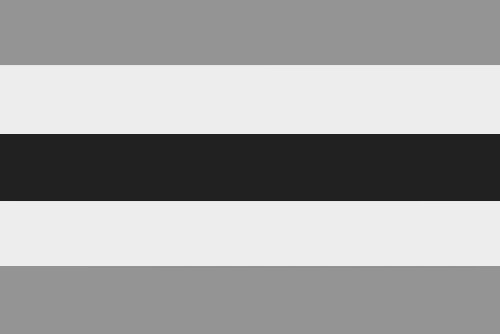
Colored based on the color palette most oft associated with anonymity and the order is from personal preference.
#not necessarily classifiable as any *distinct* gender quality/alignment since its core feature is abt ur gender being ‘up in the air’#so while *could* be- particular chosen alignments is more determined on the individual level based on personal experience & preference#just for added insight on the intentions of this term– its deliberately open-ended & flexible#lgbt coining#gender coining#flag coining#nonbinary#uingender#genderanon#ambigugender
3 notes
·
View notes
Photo
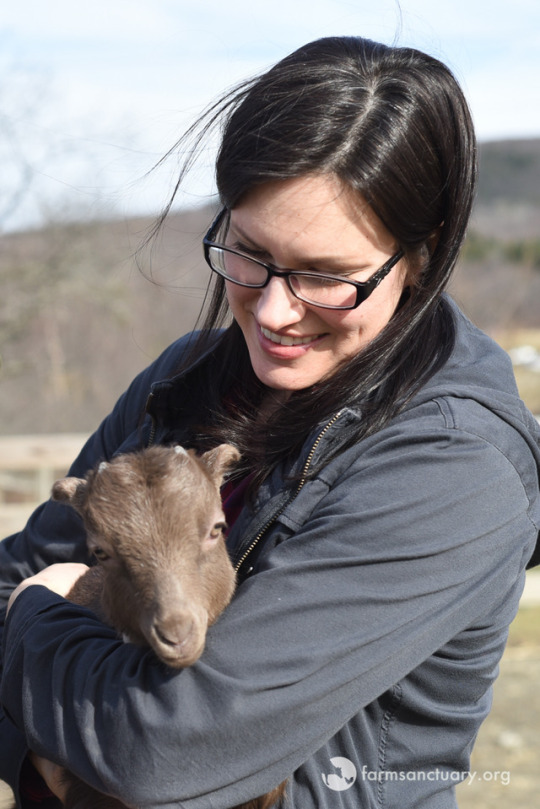
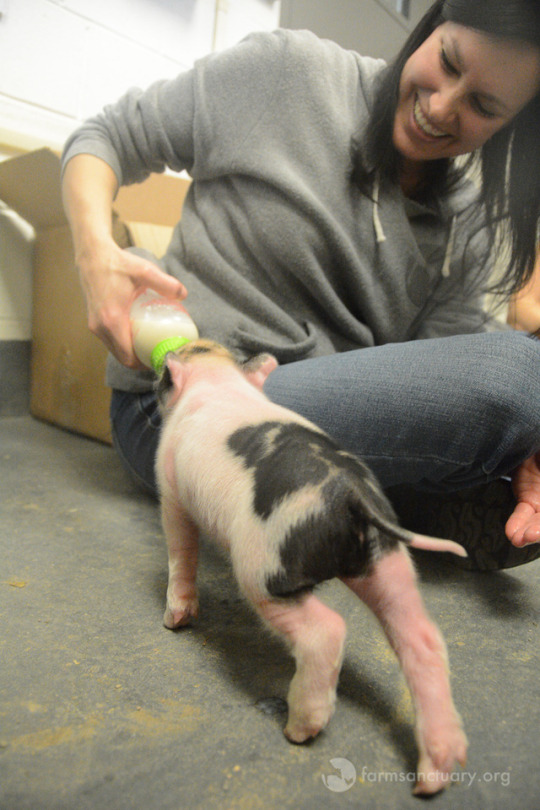
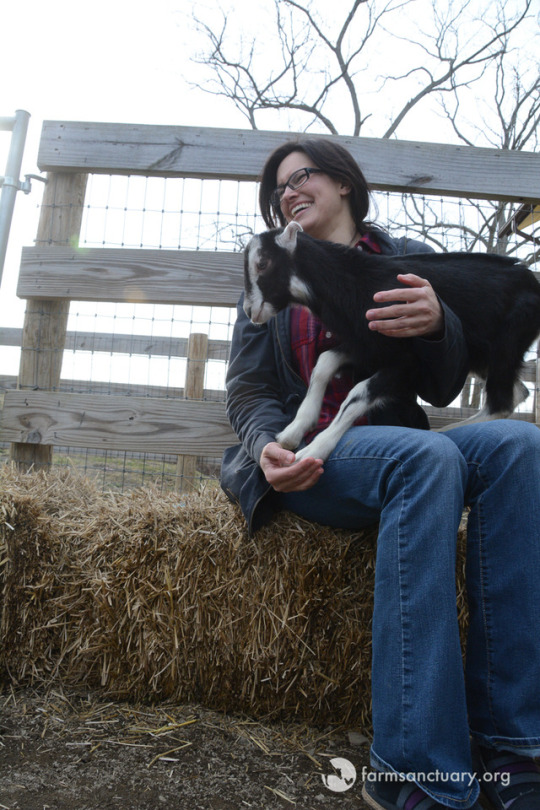
The Matchmaker: Ashley Pankratz Helps Farm Animals Find Forever Homes and Start Happy New Lives!
Close your eyes. Imagine you are driving down familiar roads, eager to return to the place where you feel most at home — that one place where you feel comfortable enough to be your true and whole self, and know that those around you will welcome you unconditionally. Every time you’re there, it feels like you're greeting an old friend — and yet there’s always something new to experience, and you find your eyes peeled as though you’re taking in your surroundings for the very first time. Here, you will always be safe, and you will always belong — and as a result, you may fulfill your potential to live and celebrate your best life possible.
For Farm Sanctuary Shelter Administrative Coordinator Ashley Pankratz, this is all part of a day’s work — the privilege and joy of placing rescued farm animals into loving forever homes, and helping them find their place as valued members of our shared planet. Under Ashley’s guidance, farm animals can find their way home — and through their journeys, we can inspire compassionate change for others just like them.
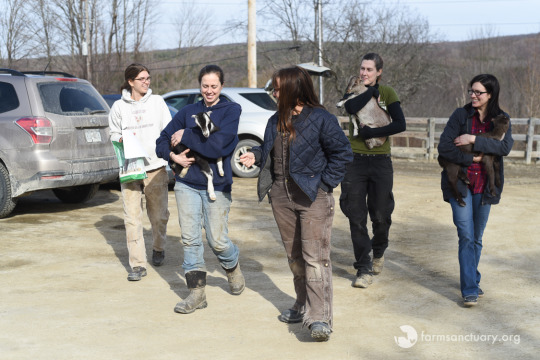
Ashley and colleagues Abbie Rogers, Tara Hess, Susie Coston, and Amy Gaetz welcome goat triplets Tove, Thomas, and Duncan home to Farm Sanctuary’s New York Shelter.
Sadly, for farm animals in the industry, transport is often a harrowing experience; animals are crammed tightly together without regard for their comfort or stress levels, often going days without proper food, water, or protection from the elements. They are separated from their families; exposed to unfamiliar and frightening sights and sounds; and either endure further exploitation or meet their untimely end upon reaching their destination. All of this is standard industry practice. But it doesn’t have to be this way — and with help from “humanimals” like Ashley, we can change the world for all beings, one individual at a time.
For most farm animals, life is a bumpy road marked by ignorance, cruelty and neglect. But it’s Ashley’s job to pave that road with promise — to help remove the obstacles these animals face, so they may instead find peace and safety at the end of it. It all starts with an inquiry: a caring person’s recognition that an animal in need is indeed an individual worthy of consideration — someone, not something. And from there, Ashley and her coworkers spring into action to try to match these incredible animals with the beautiful lives they deserve.
“I typically begin [each day] by checking Susie’s calendar and messages, and progress to voicemails that have been left on our placement lines,” Ashley explains. “We receive more calls about animals in need than most people realize, and although we can’t possibly help them all, there is nothing more thrilling than saying yes.”

Ashley feeds Pickles piglet, one of the incredible survivors we were able to say “yes” to, as colleague Jill Tedeschi looks on.
Sadly, there are more animals in need than homes available for them — an unfortunate fact that’s true at Farm Sanctuary and elsewhere. And while it can be heartbreaking to consider the sheer volume of those we cannot save (more than nine billion farm animals are slaughtered for food each year in the United States alone), it is inspiring to help the ones we can — and they, in turn, may serve as ambassadors for other farm animals just like them.
And people like Ashley are with them every step of the way — from the time we learn about an animal in need through all of our efforts to do everything we can based on each animal’s unique needs and situation. But no matter the outcome — whether we may be able to take in that particular animal ourselves or recommend alternative solutions on a case-by-case basis — their journeys have all merged unto a new, compassionate path: one where all beings we encounter are valued as individuals. And for the lucky animals we’re able to place, it’s exciting to consider how dramatically their paths will change — how transport, rather than leading to further suffering as it would in an industrial setting, instead leads to a brand new life around the bend.
During the course of a day, Ashley is always working to make these happy endings possible, whether she’s talking to a kind person alerting us to an animal in need or processing adoption applications. She’s also an integral part of day-to-day shelter operations, working closely with National Shelter Director Susie Coston on tasks ranging from record-keeping to helping Susie manage her busy schedule, and much more. Though she’s based at our Watkins Glen, NY, location, Ashley also works extremely closely with Southern California Shelter Manager Alicia Pell. “I talk to Alicia daily by phone,” she says. “She’s my other boss, and although she’s based at our Acton location in California and we’ve never actually met, I feel like we’ve known each other for much longer than we have.” And it is through this compassionate network of humanimals that we may help these incredible survivors heal and learn to love again.
For Ashley, nothing is more exciting than watching all of this hard work come to fruition in the form of being able to offer a permanent, loving home at Farm Sanctuary or with an approved member of our Farm Animal Adoption Network.
Ashley often arranges these transports — and unlike industry condotions, this time the animals enjoy plenty of nourishing food, water, and straw bedding, and have ample time to rest and relax during their journey home. Sometimes, she is directly involved in these transports herself — and she can’t help but marvel at the beautiful new beginnings made possible through compassion.

Ben David shortly after his arrival at Farm Sanctuary.
“The day I picked up Ben David was among the most memorable,” she says. “He was just a piglet, and it was the first time I had been directly involved with transport. It poured, of course — the kind of rain where you have to drive slowly. He was in a crate in the backseat, and I remember glancing frequently at him in the rearview mirror. He was making small, soft grunting sounds, and was looking out the window. You could just see him processing this new view of the world, and it was actually a profound moment for me — to think of the millions of pigs transported to slaughter, crammed onto trucks, able to glimpse the outside world rushing by through ventilation slats. What goes through their minds? We know they’re intelligent. We know they feel fear, that they are keenly aware of the fear of their friends, that they recognize the intentions of humans. And yet, here in my backseat was this tiny, lucky guy whose experience was one of wonder and curiosity. When you meet these animals up close — when you see their potential for observation and learning — you realize the gravity of what humans do to them. The surprise to me has been that this realization isn’t a one-time deal. It keeps coming daily, and it’s the reason you fight for these lives.”

Little Ben David at Farm Sanctuary.
Since starting her vegan journey, Ashley’s worldview has changed dramatically.
“I wish I could say I’ve been vegan for 20 years, but this has actually been a much more recent shift for me,” she says. “In January 2015, I decided to transition to vegetarianism, with the goal of going vegan by my 40th birthday. I knew it was something I wanted to do for ethical and environmental reasons, but veganism seemed so impossible and extreme — and like everyone else, I couldn’t imagine giving up cheese. Then I watched the trailer for Earthlings — just the trailer, which is less than two minutes! I decided to go vegan for a week, and at the end of the week, I knew that I didn’t need to look back. I’m 37 now and have been vegan for almost two years.
“I also try to do what I can in terms of activism,” she adds. “I make phone calls about animal and human rights issues. I write letters to the editor, mostly about wildlife issues. I think of these letters as an extension of farm animal activism, because wildlife policy is often determined by the interests of animal agriculture. People who eat meat usually don’t realize that there is a ‘by-catch’ to the animal products they consume — quite literally with fish, but also with the millions of wild lives who are displaced or exterminated to make room for the land animals whom society has chosen to eat.”
Ashley’s experiences demonstrate that there is no right or wrong way to make a difference — and that we need not consume ourselves with what we can’t change, while we are actively improving the world by what we can. No matter our skills, interests, or backgrounds (Ashley herself pursued a creative writing background before discovering her calling in sanctuary work), we may pool our collective passions and talents to make a difference, no matter where we are on our own personal journeys. All it takes is little spark — and in doing so, we can likewise help others find theirs. “[Visiting] the sanctuary was transforming,” Ashley says. “I knew that I wanted to align my daily work with what I’d become most passionate about.”
These days, she’s doing just that — and Ashley not only feels privileged to help these incredible animals, but to get to know them as individuals as well.
“I don’t spend as much time as I’d like to with the animals, but I have to say that the first animal [at Farm Sanctuary] who made a distinct impression on me was Cameron. I corresponded with his rescuer for a week or two before arrangements were made to transport him here, and got to know her story — along with his. Seeing him for the first time was surreal. I couldn’t believe that this animal, who’d been valued only for meat, and whose small body had been compromised by illness and injury, was finally here with us.”
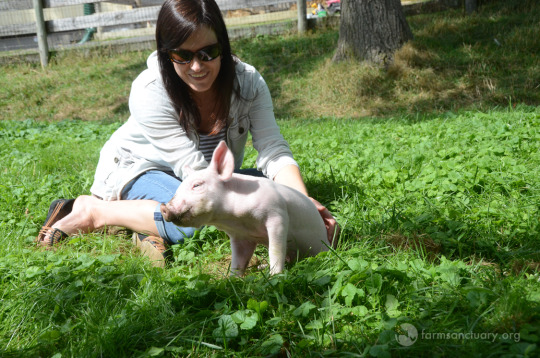
Ashley spends some quality time with Cameron during his first adventure on pasture.
Similarly, Ashley feels connected with individuals who “take life by the horns” and demonstrate that farm animals — just like us — have an innate desire to survive and thrive.
“Although I don’t see them much, I am drawn to animals who are escapees from transport trucks and slaughterhouses. Nat, for example, escaped a stockyard in Massachusetts, and was on her own in the middle of winter for about two weeks. She witnessed two other escapees get hit by cars and killed on the highway. She somehow lived through a blizzard and sub-zero temperatures, all on her own. How could you not be drawn to her?”
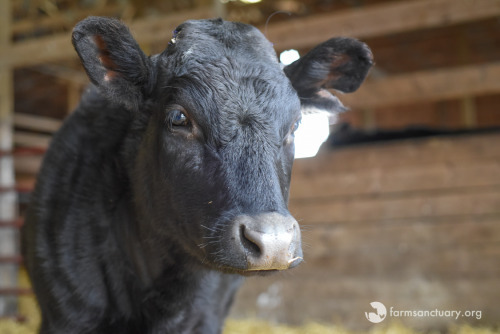
Safe at Farm Sanctuary, Natalie can savor the beautiful life she deserves.
In both her personal and professional lives, Ashley communicates that farm animals deserve as much care and regard as our companion animals and fellow humans do — and that the distinctions that cause us to see some animals as “friends” and others as “food” are completely arbitrary. When we get to know farm animals as the unique individuals they are, we may begin to understand how interconnected all beings are — and start to truly see the world through the eyes of others.

Ashley cradles Duncan, as we welcome the boys to Farm Sanctuary.
“At home, I care for three dogs, three horses, and eight cats,” Ashley says. “I find an incredible fulfillment in even the most mundane aspects of their care. For example, when I do a final goodnight check on the horses at night — sometimes it’s a hassle to suit up one more time in winter, but once I’m out there, under the stars, it’s magical. Often they rest with their noses touching, as if breathing the comfort of each other. There have been deer in the pastures on some nights, and you can see they feel safe with the horses … and that all herd animals share at least some of the same language. The interior lives and experience of animals is incredible. You have to learn to see, and to be quiet. I would say it’s an interest of mine to keep learning this.”
Of course, it can be difficult to relate to those who may not necessarily see and understand this in the same way. “Caring so deeply about animals’ lives can feel pretty isolating at times,” Ashley says. “Once I started to seriously examine the moral issues of eating animals, I felt isolated within my physical community, which is rural and heavily influenced by animal agriculture and hunting. I also experienced something similar on social media. It was astounding to see smart, sensitive friends posting pictures of the gigantic burger or steak they’d eaten for dinner. Of course, I’d probably done the same thing once or twice, but once you’re aware of the violence involved, it becomes a really horrific thing to see — especially from people you care about and otherwise respect.”
While it can sometimes feel disheartening to examine our differences, we may take comfort knowing that our similarities bring us closer — that most people want to make choices they can feel good about and are doing the best they can, with what they have, where they are. Together, we can support a compassionate world that helps us all blossom — and we have humans like Ashley to thank, for helping others see that we can all change the world, one life at a time.
Through her work each day, Ashley helps rescued farm animals find their place in the world — and by extension, she helps the humans who love them see how they, too, fit into the picture … to understand how we all have the potential to make a difference every time we put compassion first.
“Coming to Farm Sanctuary, I was able to connect with others who believe that all animals, not just cats and dogs, are worthy of our kindness,” Ashley says. “When you’re passionate about activism, that connection is nourishing, sustaining, and essential.” Together, we can raise awareness about the beautiful lives all beings deserve, and have the potential to achieve more than we could ever imagine when we choose to put compassion first.
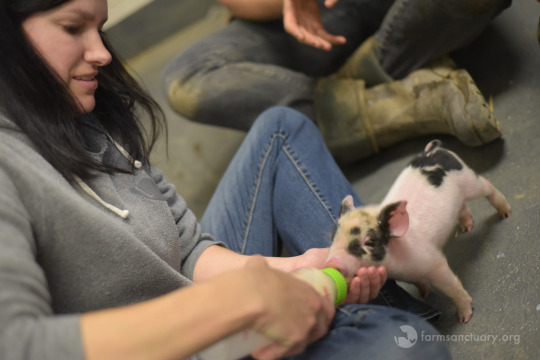
Ashley and Pickles.
#animals#animal jobs#farm animals#animal rights#vegan#new york shelter#farm animal adoption network#humanimal#Ashley Pankratz#humanimals
27 notes
·
View notes
Text
Media Report #1
Media selection: http://www.huffingtonpost.ca/2014/08/08/american-apparel-skirt-photos_n_5660594.html

Introduction
The media I have chosen are commercial advertisements and corresponding images produced by American Apparel, of which could be uncovered in/on magazines, billboards and posters, electronically via email and social media, and television. The article on the matter addresses specific “up-skirt” photographs in a back-to-school advertising scheme by American Apparel (see link above for the article). This selection coordinates with this week’s reading assignments by provoking discussion of misogyny, sexism, and women’s liberation in addition to what influence these advertisements have on viewers and members of society. Particularly, coinciding of the marketing of sex with the ways actual people arguably are negatively affected by this gendered portrayal of school girls and the way they are to be perceived and treated.
These advertisements and images alike were produced by advertising agencies under American Apparel CEO Dov Charney, CEO of the company then a consultant of their board in 2014. American Apparel brands itself as materially U.S.-based and sweatshop-free while advertises its clothes with, often, images rampant with sexualization and objectification of its male and female models. To provide context for the deployment of the advertisements in the U.S. and U.K., this CEO was fired twice from positions in the company for “misconduct [involving] sexual harassment” around that time (Alesci). This past owner of the company, when ousted from his position, promised his return to the business (or a similar venture), not acknowledging the controversy of his socially deemed wrongdoings in and outside of his business.
Interpretation
The target audience of the clothing appears to range from preteens and teenagers to late thirty-year-old individuals, with special emphasis (due to the typical age-appearance of the models in the advertisements and employees on the floor of the stores) on teenagers and early twenty-year-olds. I think the advertisements themselves are conveying to their audience messages of freedom of expression and sexuality, and a free fun youth to its audience, but above all catching the viewer’s eye and selling products with sex. The Huffington Post article, on the other hand, communicates the potential negative effects (particularly for women) of advertising with these “up-skirt” images of seemingly school girls (putting aside the unknown actual age of the female models) and the backlash on social media immediately following the deployment of these advertisements in mainstream media. The highly sexualizing and objectifying content, and its implications, are controversial in even Western cultures for the potential ramifications on (young) women and their safety, fair and equal treatment and judgment by the self and others, and general quality of life. Also, that the nature of these school girl depictions, typically considered unethical, are here normalizing of material openly pedophilic or pornogrpahic.
Specific messages of gender identities communicated here is not that of gender fluidity and the breakdown of related boundaries and categories, but of the dependence on the gender dichotomy for one’s place, role, and expectations. Of course, inclusive of how people ought to feel and appear physically. Here, women are sexual and promiscuous beings, naturally it seems in the way that women, not men, are presented this way across all the advertisements. Men, even when promiscuously garbed, are often standing up rather than sitting, leaning, or crouching beside another figure in addition to acting in control or dominating in sexual images (here the theme of women as objects and men as subjects appears). Portrayal of women in the media like this conveys aspirations and ways of being for women and men with undertones of misogyny and sexism in the way that social acceptance and praise (at least in some spheres) of men and women seem to differ to an extent, “[reproducing] norms of power and violence” (Devoss 842). Ageism and classism also come into play here as the clothing advertised to these young women as acceptable and desirable is exclusively for those who appear young as well as exclusively accessible by those of the middle to upper class.
Critical Analysis
On whether these images may be viewed as feminist or liberatory: there are many perspectives. For some, “instead of being used to enhance, resculpt, or rethink women’s bodies, [the images] are used to further control and regulate women’s bodies”, while others take the advertisements to be encouragement to sexually express and explore in ways that women were not once permitted or encouraged to do so (Devoss 837). Most likely the former would align with radical cyberfeminism while the latter would with liberal cyberfeminism for the images of gendered bodies and identities do not display gender fluidity or post-genderedness (Hall 148). In either case, feminists would agree that what it is to be a man or woman, and human, is culturally entrenched as tied to gender and so the images, while perceived as womanhood implicitly is in fact a cultural tool for imposing ideas of what it is to be, categorically of course (Sundén 217). Thus the body itself is inherently cultural as any other social institution or tool is for society.
I take the implications of the sexual and promiscuous images tied with women to be a conveyance that this is the way, and who, women are and ought to be treated and expected to behave as such. For the way women, and their male counterparts, are depicted in casual apparel like this must be the way they naturally are and an exhibition of their true roles. Female and males of the audience are caught in traps: for women, there is the pressure to be like a woman (in the traditional sense) and not be one (so, more liberatory), and for men the pressure to expect and praise one or the other type of woman and treat them as though this important distinction is to be followed (Sundén 229-230). In both cases, women and men are encouraged to disapprove and police into ostracization those who do not follow these ‘gender rules’. This internal prejudice regarding those who are or are not obedient to cultural rules, as written and rewritten in the media, leads to active and unconscious discriminatory behavior, different treatments intersectionally, and different (likely unequal) experiences and worldviews. I take the message overall, as a more liberal feminist, to be a negative one in the way that gendered notions are salient through the images in the media and so aid in the entrenchment of discriminatory cultural ideologies, though at the surface level I do not take issue with the sexual content and freeness of women in this respect.
As for the school girl images in particular, I neither find it troubling that women would choose to bend over nor promiscuously dress but that the images illicit a vibe of non-consensuality, as though the photographs were taken as women bent over on school property but not when they were attentive and accepting of the images being taken in the first place. Also, to show the schoolgirl bending over in a revealing way but not the person who is filming the incident is to facilitate a victim-blaming and rape culture in which the woman’s promiscuity is why the viewer is disturbed and uncomfortable with the image rather than due to the (invisible) photographer who distributed something typically deemed kept to the private sphere. This is of course not to say that a school girl could not possibly offer consent for the photographing or that this is culturally age-appropriate behavior by any means, but that this provides for confused feelings as regard women’s behavior in the public sphere rather than the perception, exploitation, and scape-goating of it by others.
The culture inherent in the media, and in bodies, presently disables feminism from enacting uncontroversial change because derailments from patriarchal misogyny are derailments from social norms. Images of content that implicate women’s freedom of expression and sexuality are unfortunately intertwined with all other taken-for-granted cultural understandings and so cannot be taken merely at face value. The destruction of cultural categories in technoculture is therefore a requisite in the rise of liberated sexual bodies and potential for new meanings of women’s liberation to be manifested (Sundén 219). Bodies are “inscribed, marked, engraved, by social pressures external [but are at the same time] direct effects, of the very social constitution of nature” and so bodies (228). What is womanhood and femininity, deviant and praise-worthy, feminist and patriarchal, and so on are determined by a culture, technology and bodies of which are not excluded from this. For one to spark the reinvention of the woman, body, human, and so on, one would first have to initiate change in the culture which ascribes meaning to people, which makes people significant entities or anything at all (Hall 147).
Discussion
1. Could masculinity and femininity have any part in liberatory depictions?
2. Could a focus on bodies have any part in liberatory depictions?
3. What do you see as the future of media portrayals of gender, or of people in general, assuming technology continues to progress in this way, and alongside capitalistic ventures? Does your ‘future world’ hold promise for individuals who are not luddites? That is, provide a space free of culturally entrenched biases and other categorically-based ideologies which systematically harm certain individuals over others? (Think back to “Deep Lab”).
4. In the same way that some are caused to feel uncomfortable with or threatened by images and the conceptualization of cyborgs, some are made to feel that way by liberated, sexually expressive and free, etc. women (whether in images, in person, conceptualized)? What do you think is responsible for this similarity?
Sources
Devoss’ “Rereading the Cyborg(?) Women:The Visual Rhetoric of Images of Cyborg Bodies on the World Wide Web”
Sundén’s “What Happened to Difference in Cyberspace?: The (Re)turn of the She-Cyborg”
Hall’s “Cyberfeminism”
http://money.cnn.com/2014/12/24/news/companies/dov-charney-american-apparel/
1 note
·
View note
Text
Understanding the US political divide, one word cloud at a time
http://bit.ly/2HNdbPO
In a divided United States, how can we describe who is on each side? from www.shutterstock.com
America’s political divide goes by many names – rural-urban, blue-red, metro-non-metro and left-right. We are told it is bad and that it is only getting worse, thanks to phenomena like fake news, economic uncertainty and the migration of young people away from their rural homes.
And it’s fairly common for one side of the divide to speak for the other, without knowledge of who the other really is or what they stand for. An example: The term that’s been used to describe my state’s booming economy – “Colorado’s hot streak” – is in some ways the opposite of what many rural Coloradans are experiencing. But their story rarely makes the news.
Telling someone about metro versus non-metro poverty, suicide or adult mortality rates scrapes the surface of how things are felt by those living these statistics. Descriptions never seem to do justice to how these divides are experienced, which speaks to the wisdom of the writing rule, “Show, don’t tell.”
What is that divide, really? And how can we show it?
How to communicate the divide: word clouds
I am a professor of sociology and have been studying rural and agriculture-related issues, both in the U.S. and abroad, since the late 1990s. Prior to that, I was busying growing up in rural Iowa, in the far northeast corner of the state.
A few years ago I interviewed farmers and agriculture professionals in North Dakota and members of a very different agricultural community: an urban farm cooperative. In the case of this particular urban farm cooperative, land was placed in a trust to support urban agriculture and leased to members on a sliding scale. I promised not to divulge the cooperative’s location in order to elicit participation within this group.
I wanted to know how these two communities talked and thought about issues like sustainability and food security. I was also interested in how these group members, whose lives were focused on agriculture in very different ways, illustrated some of the divides in our country.
I had a hunch these groups differed in more ways than their zip codes and socio-economic backgrounds. The North Dakota group, for instance, was all white and predominately male, whereas the urban population was considerably more diverse. The study eventually made its way into the peer-reviewed journal, Rural Sociology.
As part of the study, I built four word clouds, visual representations of words I gathered from survey questions. If a picture is worth a thousand words, these particular images show more than thousands of sentences ever could: the divergent worldviews of these two groups. And they show us an angle of the aforementioned political divide that has been missed.
Individuals in each group were asked to “select three terms that describe what ‘social justice’ means to you” and “select three terms describing what ‘autonomy’ means to you.”
Before giving their answer, participants were shown a list of some 50 terms, designed by me to relate specifically to each question. Other terms were explored as well, but only two terms – social justice and autonomy – are discussed here because they complement each other in interesting ways.
The terms respondents chose were then fed into software that generated word clouds, which are graphics that show the most-used terms in large letters, the least-used terms in smaller letters. (Disclaimer: I make no claims that these clouds speak for all Americans, farmers, North Dakotans, metro residents, etc. I also recognize that the cooperative experience could color the responses of those in the urban sample.)
Individual vs. collective
Perhaps the most immediate contrast with these social justice responses lies in how the rural North Dakotans’ image evokes a number of words associated with punishment, policing and due process, such as “eye for an eye” and “right to attorney.” These are terms associated with criminal law and the criminal justice system.
The terms chosen by the urban land cooperative, in contrast, made no reference to punishment or policing when describing their visions of social justice. Instead, they chose terms that overwhelmingly emphasized, to quote the most used term to come from this group, equity.
Word clouds provided by Michael Carolan, CC BY
There was also a divergence between groups in terms of whether social justice was something individuals achieve or whether it denotes a collective response, where a community (or even society) as a whole ensures justice for individuals. To explain this point requires that I introduce two more word cloud images, produced in response to the autonomy question.
These autonomy word clouds demonstrate that the above contrasts are no fluke and are important for two reasons. First, they validate that there is something “deeper” afoot. And second, they inform the social justice images.
Note the repeated emphasis the North Dakota group placed on terms like “individualism,” “self-determination,” “self-rule” and “authority.” In philosophical parlance, these terms align with the tradition of individualism, a position that emphasizes self-reliance and that stresses human independence and liberty.
Word clouds provided by Michael Carolan, CC BY
These terms also tie in well with the North Dakota group’s social justice word cloud, with its emphasis on words that emphasize individual responsibility, e.g., “eye for an eye,” and individual freedoms, “fair laws” and “right to attorney.”
This stands a world away from the urban farmer cooperative group, who associated autonomy with “interdependence,” “cooperation,” “solidarity” and “community.” It might appear counterintuitive to link autonomy with concepts like interdependence and solidarity, until you hear individuals from this group explain their position.
A single mother, for example, spoke directly to how independence arises for members of this group because of interdependence, rather than in spite of it.
“We can accomplish a heck of a lot more together; I feel like I have more control over my life, more independence, when we can rely on each other.” She added, “I certainly appreciate how sharing childcare opportunities as a community gives me the freedom to garden. But we can’t forget that farming has always been a collective effort, of sharing seed and knowledge and work.”
The cooperative group’s views of social justice focused significantly on community outcomes and injustices as opposed to purely individual ones. This point about the urban group expressing something resembling a collectivist understanding of social justice came out especially clear in the qualitative interviews with members of the cooperative.
Among the members’ statements was one given by a man while he was erecting tomato cages with his two brothers, uncle and another man who 12 months prior was living in his home country of Costa Rica. Asked what social justice meant to him, he said, “Justice isn’t about charity; it’s about community empowerment; not about what you’re given but about intentionally realizing your aspirations collectively.”
Disagreements can lead to dialogue
The above images reflect disagreements, to be sure, and contextualize our inability to find common ground on such issues as climate change, guns and the social safety net. If one starts from the premise that an individual can only make good, right and just decisions when they’re left alone, then their position on those hot bottom issues will look a lot different from those who think individual freedom is enhanced when those liberties are balanced out by constraints determined by ideas about the collective good. In short, consensus is a stretch when one “side” preaches self-reliance and self-rule while the other speaks of “independence” and needing to “rely on each other” in the same sentence, as the mother from the cooperative did.
So what does this study of these two groups and their ideas mean? Does bridging the political divide in the U.S. mean groups like this need to settle all of their political disputes and arrive at consensus about everything?
Of course not. Disagreements are good when they encourage dialogue and debate.
What we have now in our country appears to sometimes border on combativeness if not outright hate, which has me deeply concerned, both as a sociologist and a citizen.
Before we can hope to repair the divides (plural, since these differences clearly go beyond rural-urban) we need to first understand how deep they cut. You wouldn’t prescribe a Band-Aid for a gash that requires stitches. The following are three concluding thoughts as we triage this wound.
Replace caricatures with actual encounters
First, the opposing worldviews illustrated in the word clouds have less to do with each group having different levels of knowledge and more to do with processing knowledge through very different filters. Thus, settling political disputes by arguing over “the facts” is futile, at least in some instances.
Second, a few respondents from each group appeared to be straddling “worlds.” People like this can be very helpful in bridging our political divides. Instead of building alliances based on geopolitical identities (e.g., ethnicity, political affiliation, rural/urban), we might explore how this process could start by engaging those who, like these few respondents, share similar worldviews.
Third, these worlds risk growing further apart the more their respective inhabitants look inward. The alternative would involve creating situations where we can get to know some of the people and livelihoods that are a world away from what we otherwise experience. That means the caricatures of rural and urban America need to be replaced with actual encounters.
Whoever thinks fences make for good neighbors has been infected by today’s political climate. What we need are bridges. It is time we start building them – and walking across the political divide.
Michael Carolan receives funding from the National Research Foundation of Korea and by the National Institute of Food and Agriculture .
0 notes